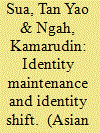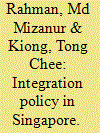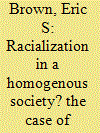| Srl | Item |
| 1 |
ID:
117695


|
|
|
|
|
| Publication |
2013.
|
| Summary/Abstract |
This paper examines the state of identity maintenance and identity shift among the Tirok Chinese Peranakan in Terengganu who are an acculturated rural Chinese community in a Malay populated area. The current older generation still maintains the Peranakan identity, featuring strong Malay cultural influence. Their acculturation by the larger Malay community could be attributed to the combination of three factors: confinement to a Malay environment, common schooling with the local Malays and strong Sino-Malay ties. Malay cultural influence is most evident in their spoken language, building architecture, dressing style, cuisine, eating habits and female inheritance rights. However, amidst acculturation, they still maintain a strong Chinese identity that has been manifested through their observance of Chinese religious and cultural practices, their usage of the Chinese dialect as the home language, their preference for wearing Chinese-style attire in public and their preference for intra-ethnic marriages. But the Peranakan identity has been eroded over the years. There is a noticeable identity shift among the current younger generation as new intervening socio-cultural factors have reduced their interactions with the local Malays and heightened their Chinese identity. The degree of identity shift, however, differs between the current second and third generations and also between those who have moved to town and those who remain in Tirok.
|
|
|
|
|
|
|
|
|
|
|
|
|
|
|
|
| 2 |
ID:
117696


|
|
|
|
|
| Publication |
2013.
|
| Summary/Abstract |
A number of models of integration have been developed to highlight the experiences of immigration and integration in the Western world. However, the existing models do not adequately capture the complexities of contemporary international immigration and integration, especially the integration process in the light of migrant transnationalism in Asia. This study examines the models of integration through a case study of Singapore. This paper introduces a new concept 'transnational inclusion' to conceptualize Singapore's initiative to embrace its transnational global Singaporeans as well as its transnational immigrants, estimated to make up one-fourth of the total population. The paper shows that a transnational inclusion model of integration can provide better insights into the dynamics of transnationalism and integration in today's complex migration scenario. We point to Singapore's integration approach that regards integrating migrants into the different spheres of the society as a process rather than an end.
|
|
|
|
|
|
|
|
|
|
|
|
|
|
|
|
| 3 |
ID:
117694


|
|
|
|
|
| Publication |
2013.
|
| Summary/Abstract |
Chosonjok migrant brides are Korean Chinese women who married South Korean men (hereafter Korean men). The number of Chosonjok migrant brides increased rapidly until recently due to the attempts of the central and local governments of Korea to resolve bride shortages in rural areas in the early 1990s and the Koreans' preference for ethnic Korean brides over non-Korean foreign brides. Currently there are more than 26,000 Chosonjok migrant brides in Korea. Due to the drastic changes to their post-migration lives in their ethnic homeland of Korea, most Chosonjok migrant brides experience changes in their ethno-national identity(ies). This paper investigates this process and the underlying reasons for these post-ethnic return migration identity changes. It also looks at the types of identity changes that occur through in-depth interviews with 22 Chosonjok migrant brides in Korea.
|
|
|
|
|
|
|
|
|
|
|
|
|
|
|
|
| 4 |
ID:
117693


|
|
|
|
|
| Publication |
2013.
|
| Summary/Abstract |
This paper examines the puzzling status of Buraku people in Japan through the methodological prism of historical sociology. I develop a theoretical approach that emphasizes the concept of racialization to illuminate the historical and social construction of Buraku status. I propose this approach as a complementary alternative to prior analytic perspectives. Two major perspectives have dominated research on the status of Buraku people. First, an earlier approach that focused on the legacy of caste discrimination. The second framework focuses on Buraku people as part of the struggle for universal human rights. This article raises three basic, but interrelated questions about the historical development of Buraku status in Japan. Why did the Buraku people become subject to such overt discrimination in local community life, and through government policy? How was the state involved in the social construction of Buraku people? How did the Buraku liberation struggles challenge formalized discrimination?
|
|
|
|
|
|
|
|
|
|
|
|
|
|
|
|